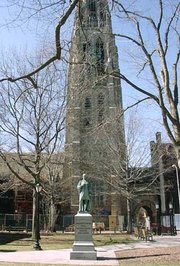Harkness Tower
|
|
Harkness_Tower_1.jpg
Harkness Tower
Harkness Tower is a prominent Gothic structure at Yale University in New Haven, Connecticut, built from 1917 to 1921.
The tower was constructed as part of the Memorial Quadrangle donated to Yale by Anna M. Harkness in honor of her recently deceased son. It was designed by James Gamble Rogers, who designed many of Yale's "Collegiate Gothic" structures and was inspired by "Boston Stump," the 15th-century high tower of the parish church (of St Botolph) in Boston, England, the parish church with the highest tower in all of England, with some details from a tower at Elihu Yale's burial site, Saint Giles in Wrexham, Wales. It was, when built, the only couronne ("crown") tower in English Perpendicular Gothic style that had been constructed in the modern era.
It is 216 feet tall, with a square base rising in stages to a double stone crown on an octagonal base, dissolving at the top in a spray of stone pinnacles. It was built of separate stone blocks in the authentic manner, and was at the time the tallest free-standing stone structure in the world; since then it has been reinforced as a precaution. Four copper clockfaces tell the hours midway to the top of the tower. The tower contains the Harkness Carillon, a 54-bell carillon, installed in 1961, replacing a 10-bell version, which is played by members of a university club set up for the purpose. (Some residents of Branford College and Saybrook College, of which Harkness forms a part of the periphery, have been known to call the daily performances "death by bells.")
Its decorative elements were sculpted by Lee Lawrie (1877-1963). The lowest level of sculpture depicts Yale's Eight Worthies: Elihu Yale, Jonathan Edwards, Nathan Hale, Noah Webster, James Fenimore Cooper, John C. Calhoun, Samuel F. B. Morse, and Eli Whitney. The second level of sculpture depicts Phidias, Homer, Aristotle, and Euclid. The next level of sculpture consists of allegorical figures depicting Medicine, Business, Law, the Church, Courage and Effort, War and Peace, Generosity and Order, Justice and Truth, Life and Progress, and Death and Freedom. The gargoyles on the top level depict Yale's students at war and in study (a pen-wielding writer, a proficient athlete, a tea-drinking socialite, and a diligent scholar), along with masks of Homer, Virgil, Dante, and Shakespeare.
The witticism, usually attributed to a famous modernist architect (likely Frank Lloyd Wright), that had he "to choose any place in New Haven to live" he would select the Harkness Tower, for then he "would not have to look at it," is apparently apocryphal (and is in any case derivative of a similar story told of Alexandre Dumas and the Eiffel Tower). The tower's image was adopted by the Yale Herald, the undergraduate weekly newspaper, for its masthead.
External link
- Comparison with St Botolph's (http://www.library.yale.edu/archives300/exhibits/building/part2/page15.htm)

